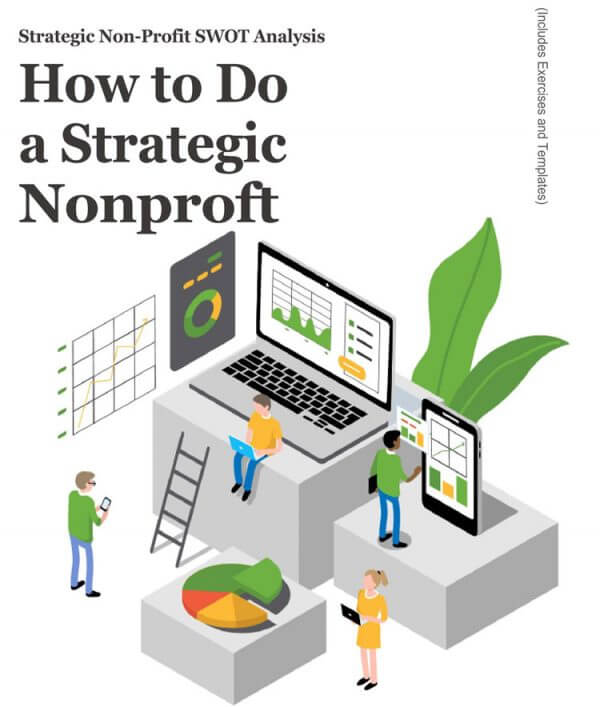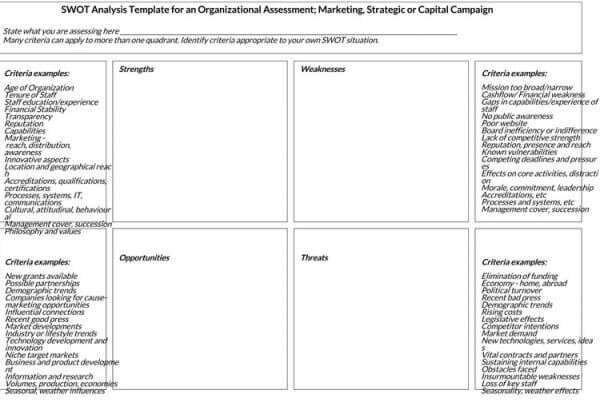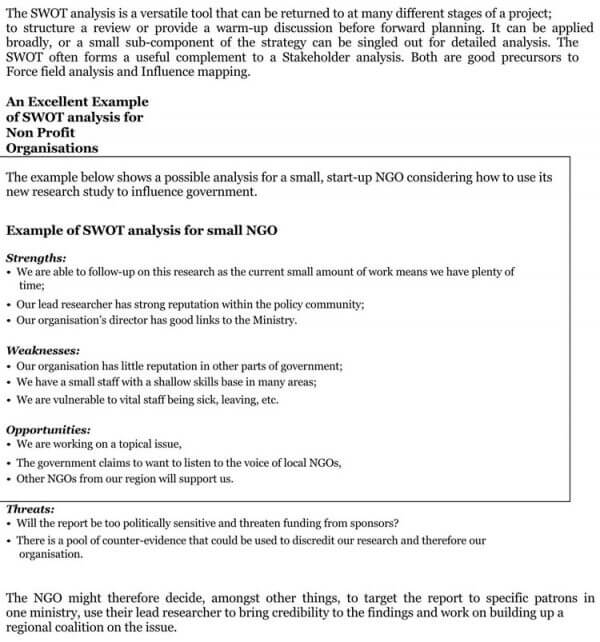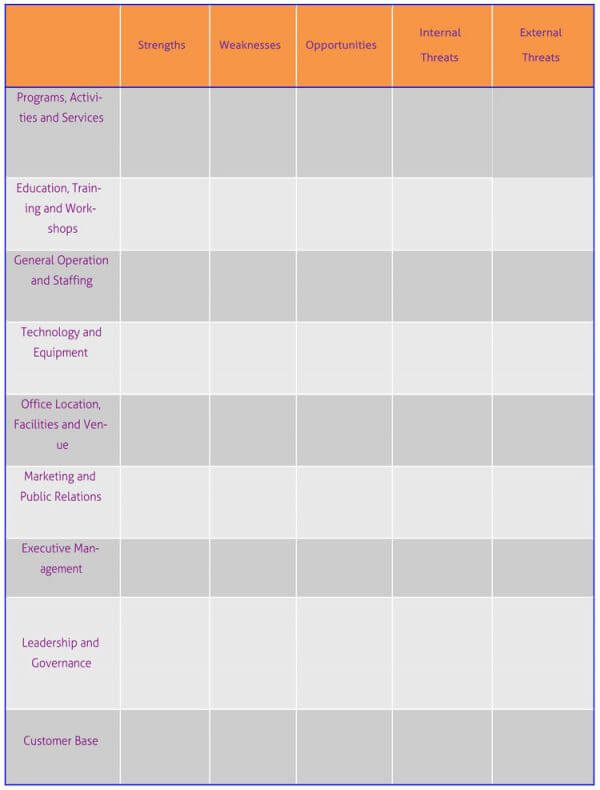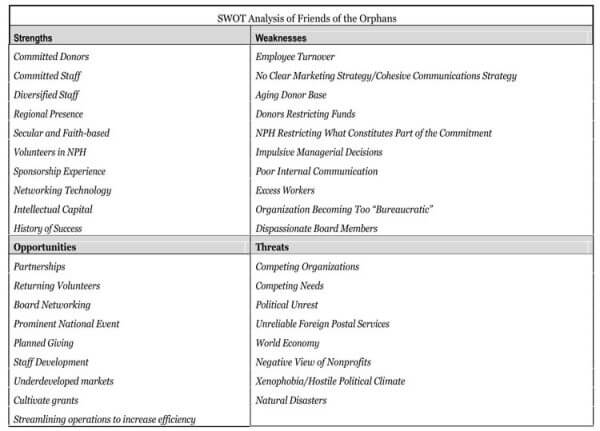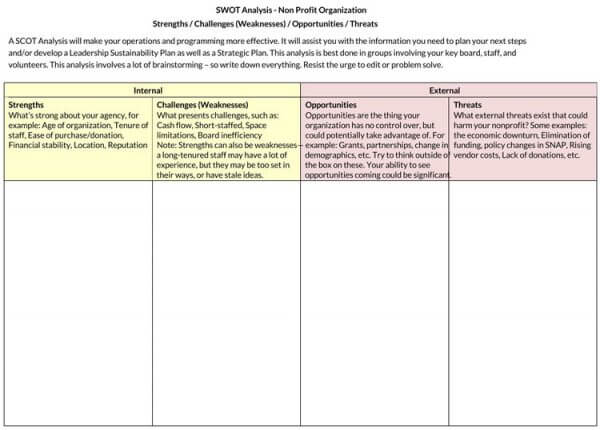SWOT analysis serves to get ideas off the paper. This method helps any project plan its implementation more securely and devise strategies with a better chance of success. It can be done by discovering the strengths, weaknesses, opportunities, and threats to the non-profit. The strengths of a non-profit are volunteering and donations, weaknesses include over-reliance on donations opportunities include state incentives, and threats include too much competition.
The completeness of its diagnosis allows the SWOT analysis to serve to support any critical decision-making about the organisation. Therefore, the method is generally employed at any time of significant change.
The main benefits of applying SWOT analysis include:
- Security in decision-making;
- Realistic recognition of the working scenario;
- Assertive understanding of competition;
- The anticipation of trends;
- Planning of action alternatives.
It is recommended that the SWOT analysis be carried out periodically so that the administrative and strategic actions adopted are still consistent with the reality of the agency since both the internal and external staff of the SWOT Matrix are continually changing.
How to Conduct a SWOT Analysis for Non-profit
The first step to conducting a SWOT analysis for a non-profit is to find out where the strengths of the non-profit lie. It is a question of determining the characteristics that put the particular non-profit in a position of strength concerning all other non-profits both within the niche choice and other areas of specialization.
Also of concern are the characteristics that make the non-profit organisation stronger on its own, as well as those traits that it can draw on to help it grow. Some of the strengths of a non-profit include the fact that most of the work is done by volunteers. Non-profits often behave as for-profit organizations as they operate in an increasingly competitive environment. Demand for services always exceeds the funds available to support the causes. Therefore, to remain relevant, today’s non-profits often invest energy in marketing schemes.
Internal Factors
In the internal environment, it is possible to have control of everything that involves it, such as intellectual capacity, the technology used, communication and marketing actions, organizational culture, project management, among others. Within the internal environment, one must analyze the strengths and weaknesses.
To better understand, consider that you need to evaluate criteria such as:
- The location of the organization
- Market time
- Reputation
- Financial resources
- Human resources, team-specific skills
- Marketing/media
- Management
- Access to raw materials
- The ability to operate
- Assets, such as real estate, materials and equipment (the quality of technology)
- The service
- Production
- Creation;
- The strategic relationship with large companies;
- Traffic, customer portfolio.
In the aspect of the analysis, reference is made to the SWOT matrix. It corresponds to the structuring of a scheme in the form of a table divided into different quadrants. Each corresponds to an acronym of the matrix; one quadrant is reserved for strengths and another for weaknesses. These are intrinsic aspects of an organisation, constitutes its priority.
The other quadrants correspond to the elements outside it, such as opportunities and threats, the former must be exploited to enhance the industry, and the latter must be detected and neutralized so that they do not cause harm to the processes of the organization.
The identifiable shortcomings in a SWOT analysis for a non-profit organisation include all the factors that put the organisation in a weak position. These things could include the fact that contributions and donations bear them.
It is something that non-profit organisations can’t control because they can’t force people to give them the money. As such, the non-profit organisation is forced to depend on the goodwill of taxpayers. Since it has no way of predicting how much it will receive in each business cycle, this makes it challenging to create a budget.
Opportunities for a Non-profit
Opportunities in a SWOT analysis for non-profit include factors such as state incentives. Most non-profits are eligible for all types of public contributions, which they can apply to their mission.
Besides grants, they are eligible for tax deductions and exemptions as well as the release of capital that can be applied to their work. Other opportunities that can be capitalised on include the ability to organise fundraisers to help them make money and the ability to organise other functions such as lottery drawings.
It, coupled with the long experience they may have in the area, are the greatest strengths, and that is that having gained a good reputation as well as an excellent image before society makes an organisation like this the busiest.
Threats and External Weaknesses For Non-Profits
Threats in a SWOT analysis for a non-profit includes all those aspects that threaten the survival of the non-profit. The main threat to non-profits is a slowdown in the economy, which translates into a decrease in charitable donations. Another threat is too much competition from too many non-profits working for the same purpose.
It makes it harder for people to choose which non-profits to donate to, and also leads to a division of funds into smaller portions. Among the weaknesses, there can be a shortage of staff which means that it cannot on many occasions develop all those activities for which it wishes to be projected, this scarcity is due to the lack of payment of wages and little disposition of people.
As far as opportunities are concerned, they are due to the projective analysis carried out on society and the different needs that society can manifest and thus be able to offer the services that respond to them.
Free Templates (SWOT Analysis for Non-profit)
As by now; you must have understood how and why a non-profit organization needs to conduct a SWOT analysis. It is now time to conduct your NPO’s SWOT analysis. For your ease, download our free-of-cost & 100% customizable templates for SWOT analysis of an NPO in a click from below!
FAQs
What factors pose as threats or opportunities to my organization generally?
Here are some factors you can assess if they pose threats or opportunities to your organization:
● Competitors (what is the number of organizations in the sector? How do they relate? What is the level of rivalry?);
● New entrants (how are the barriers to entry into the sector? What threats can they pose?);
● Substitutes (is it easy to find workarounds? Is there any project that threatens your organization?);
● Intermediaries (are there intermediaries in your sector? Do they have bargaining power over your organization?);
● Class entities (how do class entities are organized? Do they have pressure power?).
Who should do the SWOT Analysis?
You probably think that because it is a method of project management, who should apply the SWOT analysis are the managers. But who are the people who know the organisation’s ins and out so? It is the employees who live the day to day of the business!
Therefore, SWOT analysis is richer when it integrates the entire team to collect information. Thus, each person can contribute to the reality that lives in their routines.
We are well-aware that a non-profit organization is also subject to market competition and has accordingly to maintain its place in the market. It is devastating to experience loss. The purpose of SWOT analysis is to help non-profits produce an action plan to support what works, change what doesn’t work, seize opportunities, and minimize loss!
